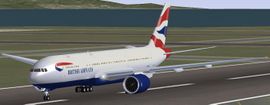Boeing 777: Difference between revisions
(New page: thumb|270px|[[Boeing 777-200 in Britisch Airways livery]] The '''Boeing 777''' is a long-range, wide-body twin-engine airliner built by Boeing Commercial Airplanes. ...) |
mNo edit summary |
||
| Line 1: | Line 1: | ||
[[Image:777-200.jpg|thumb|270px|[[Boeing 777-200]] in | [[Image:777-200.jpg|thumb|270px|[[Boeing 777-200]] in British Airways livery]] | ||
The '''Boeing 777''' is a long-range, wide-body twin-engine airliner built by Boeing Commercial Airplanes. The world's largest twinjet and commonly referred to as the "Triple Seven", it can carry between 283 and 368 passengers in a three-class configuration and has a range from 5,235 to 9,450 [[nautical mile]]s (9,695 to 17,500 km). Distinguishing features of the 777 include the six wheels on each main landing gear, its circular fuselage cross section, the largest diameter turbofan engines of any aircraft, the pronounced "neck" aft of the flight deck, and the blade-like tail cone. | The '''Boeing 777''' is a long-range, wide-body twin-engine airliner built by Boeing Commercial Airplanes. The world's largest twinjet and commonly referred to as the "Triple Seven", it can carry between 283 and 368 passengers in a three-class configuration and has a range from 5,235 to 9,450 [[nautical mile]]s (9,695 to 17,500 km). Distinguishing features of the 777 include the six wheels on each main landing gear, its circular fuselage cross section, the largest diameter turbofan engines of any aircraft, the pronounced "neck" aft of the flight deck, and the blade-like tail cone. | ||
Revision as of 23:27, 3 October 2008

The Boeing 777 is a long-range, wide-body twin-engine airliner built by Boeing Commercial Airplanes. The world's largest twinjet and commonly referred to as the "Triple Seven", it can carry between 283 and 368 passengers in a three-class configuration and has a range from 5,235 to 9,450 nautical miles (9,695 to 17,500 km). Distinguishing features of the 777 include the six wheels on each main landing gear, its circular fuselage cross section, the largest diameter turbofan engines of any aircraft, the pronounced "neck" aft of the flight deck, and the blade-like tail cone.
As of May 2008, 56 customers have placed orders for 1,080 777s. Direct market competitors to the 777 are the Airbus A330-300, A340, and some variants of the A350 XWB, which is currently under development. The 777 may eventually be replaced by a new product family, the Boeing Y3, which would draw upon technologies from the 787.
Variants
| |||||||||||